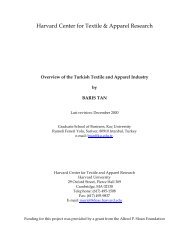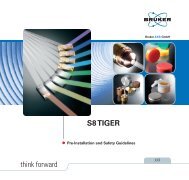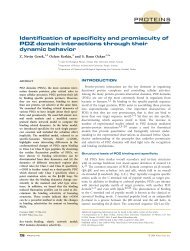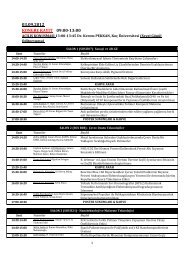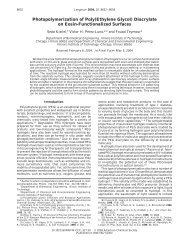The Bioartificial Pancreas: Progress and Challenges Review
The Bioartificial Pancreas: Progress and Challenges Review
The Bioartificial Pancreas: Progress and Challenges Review
Create successful ePaper yourself
Turn your PDF publications into a flip-book with our unique Google optimized e-Paper software.
THE BIOARTIFICIAL PANCREAS 973<br />
cose-responsive insulin-producing cells using<br />
inductive signals involved in normal pathways<br />
of islet development. Compared with other<br />
methods for insulin-producing cell development<br />
from human stem cells, 91,93 the method<br />
developed by this group produced insulin at<br />
the highest levels yet achieved from an exp<strong>and</strong>able,<br />
human stem cell-derived tissue.<br />
However, the method developed in the study<br />
still needs to be improved, perhaps through the<br />
addition of glucagon-like peptide-1, transforming<br />
growth factor- lig<strong>and</strong>s, or other factors<br />
to potentiate -cell maturation, growth,<br />
<strong>and</strong> insulin secretion. 94–96<br />
Gene therapy has also been suggested as a<br />
treatment of insulin-dependent diabetes mellitus.<br />
This strategy can be applied by preventing<br />
the autoimmune destruction of -cells, 97,98 by<br />
regenerating -cells, 99,100 or by engineering insulin-secreting<br />
surrogate -cells. 99,101–103 Sapir<br />
et al. 104 recently suggested the potential use of<br />
adult human liver as an alternate tissue for autologous<br />
-cell-replacement therapy. Using<br />
pancreatic <strong>and</strong> duodenal homeobox gene 1<br />
(PDX-1) <strong>and</strong> soluble factors, they managed to<br />
induce a comprehensive developmental shift of<br />
adult human liver cells into functional insulinproducing<br />
cells. According to the findings of<br />
that study, PDX-1-treated human liver cells expressed<br />
insulin, stored it in defined granules,<br />
<strong>and</strong> secreted the hormone in a glucose-regulated<br />
manner. When these cells were implanted<br />
under the renal capsule of immunodeficient<br />
mice with diabetes, the cells ameliorated hyperglycemia<br />
for prolonged periods of time. <strong>The</strong><br />
technique offers both the potential of a cell-replacement<br />
therapy for patients with diabetes<br />
<strong>and</strong> allows the patient to be the donor of his or<br />
her own insulin-producing tissue.<br />
Intestinal K cells have also been engineered<br />
to express <strong>and</strong> secrete insulin in a glucose dependent<br />
manner, generating functional cells.<br />
105,106 With the development of robust <strong>and</strong><br />
safe gene therapy, this strategy may lead to effective<br />
therapy in the future.<br />
Preservation of encapsulated cell systems<br />
<strong>The</strong> last challenge for a bioartificial pancreas<br />
to become a routine clinical application is the<br />
long-term cryopreservation of encapsulated<br />
cells. Validated technologies are required for<br />
long-term preservation of encapsulated cell systems<br />
to maintain a product inventory, <strong>and</strong> in order<br />
to meet end-user dem<strong>and</strong>s. One of the current<br />
strategies for overcoming the problem of<br />
cryopreservation of tissue is the reduction of cryoprotectant<br />
[dimethyl sulfoxide (DMSO)] concentration<br />
or complete replacement by equally<br />
powerful substances. Recent work in Dr. Opara’s<br />
laboratory has demonstrated that cryopreservation<br />
of islet cells cultured overnight in the presence<br />
of 10% polyvinylpyrrolidone yielded higher<br />
intact islet recovery compared with islets frozen<br />
in the presence of DMSO <strong>and</strong> glycerol. 107 <strong>The</strong><br />
lower islet cell integrity <strong>and</strong> function were explained<br />
on the basis of hypothesis that low-molecular-weight<br />
compounds, such as DMSO <strong>and</strong><br />
glycerol, permeate the cell <strong>and</strong> interact hydrophobically<br />
with intracellular proteins, which<br />
results in perturbed cytoskeletal architecture of<br />
the frozen cells <strong>and</strong> diminished islet cell integrity<br />
<strong>and</strong> function.<br />
<strong>The</strong> other promising technical improvement<br />
of the cryopreservation technology is the reduction<br />
of total sample volume. Miniaturization<br />
of the cryosubstrates from 1 mL to microliters<br />
reduces temperature gradients in cryosubstrates,<br />
which makes it possible to achieve<br />
higher freezing rates <strong>and</strong> more homogeneous<br />
freezing of the sample. 108 Islets cryopreserved<br />
with this strategy were highly functional even<br />
with the lower DMSO concentrations. 109<br />
Misler et al. 110 studied stimulus–secretion<br />
coupling in whole islets as well as single cells<br />
from carefully selected cryopreserved <strong>and</strong><br />
thawed human islets of Langerhans. <strong>The</strong>y found<br />
that without using any of the recent advances in<br />
cryopreservation technique, cryopreserved <strong>and</strong><br />
thawed human islets, which were selected based<br />
on their smooth surface <strong>and</strong> diameter, responded<br />
to glucose in a calcium- <strong>and</strong> metabolicdependent<br />
fashion. In another study by von<br />
Mach et al., 111 viability of pancreatic islets after<br />
cryopreservation was correlated negatively with<br />
their size, <strong>and</strong> suppression of insulin release was<br />
not observed for islets 300 m.<br />
DIFFERENT FORMS OF BIOARTIFICIAL<br />
PANCREAS<br />
Various configurations have been studied for<br />
the purpose of immunoisolation of islets. <strong>The</strong>se



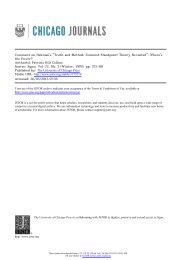
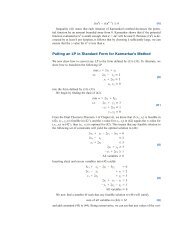
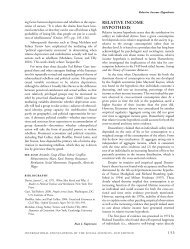
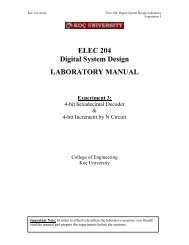
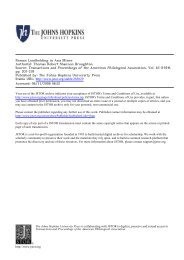
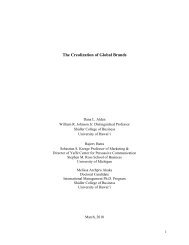

![]_[O](https://img.yumpu.com/10363126/1/190x138/-o.jpg?quality=85)
